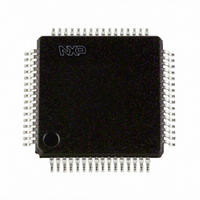SC16C554IB64,151 NXP Semiconductors, SC16C554IB64,151 Datasheet - Page 28

SC16C554IB64,151
Manufacturer Part Number
SC16C554IB64,151
Description
IC UART QUAD SOT314-2
Manufacturer
NXP Semiconductors
Specifications of SC16C554IB64,151
Number Of Channels
4, QUART
Fifo's
16 Byte
Voltage - Supply
2.5V, 3.3V, 5V
With Auto Flow Control
Yes
With Irda Encoder/decoder
Yes
With False Start Bit Detection
Yes
With Modem Control
Yes
With Cmos
Yes
Mounting Type
Surface Mount
Package / Case
64-LQFP
Transmit Fifo
16Byte
Receive Fifo
16Byte
Transmitter And Receiver Fifo Counter
Yes
Data Rate
5Mbps
Package Type
LQFP
Operating Supply Voltage (max)
5.5V
Operating Supply Voltage (min)
4.5V
Mounting
Surface Mount
Operating Temperature (min)
-40C
Operating Temperature (max)
85C
Operating Temperature Classification
Industrial
Lead Free Status / RoHS Status
Lead free / RoHS Compliant
Other names
935270074151
SC16C554IB64-S
SC16C554IB64-S
SC16C554IB64-S
SC16C554IB64-S
Philips Semiconductors
9397 750 13132
Product data
7.5 Line Control Register (LCR)
The Line Control Register is used to specify the asynchronous data communication
format. The word length, the number of stop bits, and the parity are selected by
writing the appropriate bits in this register.
Table 14:
Bit
7
6
5
4
3
2
1:0
Line Control Register bits description
Symbol
LCR[7]
LCR[6]
LCR[5]
LCR[4]
LCR[3]
LCR[2]
LCR[1:0]
Quad UART with 16-byte FIFO and infrared (IrDA) encoder/decoder
Rev. 05 — 10 May 2004
Description
Divisor latch enable. The internal baud rate counter latch and
Enhance Feature mode enable.
Set break. When enabled, the Break control bit causes a break
condition to be transmitted (the TX output is forced to a logic 0
state). This condition exists until disabled by setting LCR[6] to a
logic 0.
Set parity. If the parity bit is enabled, LCR[5] selects the forced
parity format. Programs the parity conditions (see
Even parity. If the parity bit is enabled with LCR[3] set to a logic 1,
LCR[4] selects the even or odd parity format.
Parity enable. Parity or no parity can be selected via this bit.
Stop bits. The length of stop bit is specified by this bit in
conjunction with the programmed word length (see
Word length bits 1, 0. These two bits specify the word length to be
transmitted or received (see
Logic 0 = Divisor latch disabled (normal default condition).
Logic 1 = Divisor latch and enhanced feature register enabled.
Logic 0 = no TX break condition (normal default condition).
Logic 1 = forces the transmitter output (TX) to a logic 0 for
alerting the remote receiver to a line break condition.
Logic 0 = parity is not forced (normal default condition).
LCR[5] = logic 1 and LCR[4] = logic 0: parity bit is forced to a
logical 1 for the transmit and receive data.
LCR[5] = logic 1 and LCR[4] = logic 1: parity bit is forced to a
logical 0 for the transmit and receive data.
Logic 0 = ODD Parity is generated by forcing an odd number of
logic 1s in the transmitted data. The receiver must be
programmed to check the same format (normal default
condition).
Logic 1 = EVEN Parity is generated by forcing an even number
of logic 1s in the transmitted data. The receiver must be
programmed to check the same format.
Logic 0 = no parity (normal default condition).
Logic 1 = a parity bit is generated during the transmission,
receiver checks the data and parity for transmission errors.
Logic 0 or cleared = default condition.
Logic 0 or cleared = default condition.
Table
SC16C554/554D
© Koninklijke Philips Electronics N.V. 2004. All rights reserved.
17).
Table
Table
15).
16).
28 of 55















